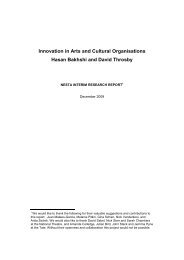Rumbling on performativity_Frits Simon
Rumbling on performativity_Frits Simon
Rumbling on performativity_Frits Simon
Create successful ePaper yourself
Turn your PDF publications into a flip-book with our unique Google optimized e-Paper software.
I have reproduced Verschuren’s (2009: 48) overview to give a general impressi<strong>on</strong> how<br />
his comparis<strong>on</strong> works out. Double plus means that a criteri<strong>on</strong> is very str<strong>on</strong>gly demanded<br />
for, <strong>on</strong>e plus means str<strong>on</strong>gly, plus minus means to some extent and minus means<br />
not or barely demanded for. Up till now the demands from ‘outside science’ I indicated<br />
by relevance, the demands from ‘within science’ I indicated by external and internal<br />
relevance. Later <strong>on</strong> I will discuss other criteria. I added the last column to explain<br />
Verschuren’s criteria with a short entry.<br />
Table 1: Verschuren’s comparis<strong>on</strong> of demands for research<br />
Demands from<br />
Theory<br />
Practice-based<br />
Explanati<strong>on</strong><br />
driven<br />
N-<br />
n-<br />
type<br />
type<br />
Within<br />
1<br />
internal validity<br />
++<br />
++<br />
++<br />
exactness, credibility<br />
science<br />
2<br />
external validity<br />
++<br />
+<br />
+-<br />
generalizability<br />
3<br />
c<strong>on</strong>trollability<br />
++<br />
++<br />
++<br />
transparent data collecti<strong>on</strong><br />
4<br />
cumulativity<br />
++<br />
+-<br />
+-<br />
c<strong>on</strong>tributi<strong>on</strong> to knowledge<br />
Outside<br />
science<br />
Object<br />
5<br />
6<br />
7<br />
8<br />
9<br />
changeability<br />
new phenomen<strong>on</strong><br />
(group)process<br />
interrelatedness<br />
small target group<br />
+-<br />
+-<br />
+-<br />
-<br />
-<br />
+<br />
+<br />
+<br />
+-<br />
-<br />
++<br />
++<br />
++<br />
++<br />
++<br />
present amount of change<br />
amount new developments<br />
influence of processes<br />
c<strong>on</strong>necti<strong>on</strong>s am<strong>on</strong>g people<br />
amount of involved people<br />
Outside<br />
10<br />
understandability<br />
-<br />
+-<br />
++<br />
related to target group<br />
science<br />
11<br />
acceptati<strong>on</strong> /<br />
-<br />
+-<br />
++<br />
related to target group<br />
Needs<br />
legitimacy<br />
12<br />
research as<br />
-<br />
-<br />
++<br />
related to purpose research<br />
learning process<br />
Outside<br />
science<br />
13<br />
14<br />
holism<br />
multidisciplarinity<br />
-<br />
-<br />
+-<br />
+<br />
++<br />
++<br />
cohesive insight<br />
cohesive insight<br />
Knowledge<br />
15<br />
manipulability<br />
-<br />
+<br />
++<br />
<strong>on</strong> behalf of interventi<strong>on</strong>s<br />
From Verschuren’s perspective it is easy to understand that criteria 8 up till 15 are<br />
relatively important for both N/n-types of research. This types of research are aiming<br />
at solving a problem, implying that the research has to have c<strong>on</strong>sequences for the<br />
behaviour of pers<strong>on</strong>s. Within N-type research rather indirectly, within n-type research<br />
quite directly as it c<strong>on</strong>cerns people nearby the researcher. Theory-driven research is<br />
positi<strong>on</strong>ed as rather opti<strong>on</strong>al regarding practical c<strong>on</strong>sequences, as if there are <strong>on</strong>ly<br />
c<strong>on</strong>ceptual c<strong>on</strong>sequences. Therefore according to Verschuren for theory-driven research<br />
the demands have less to do with what happens am<strong>on</strong>g people, or what hap-<br />
2. Research from a complex resp<strong>on</strong>sive process-approach | 45



